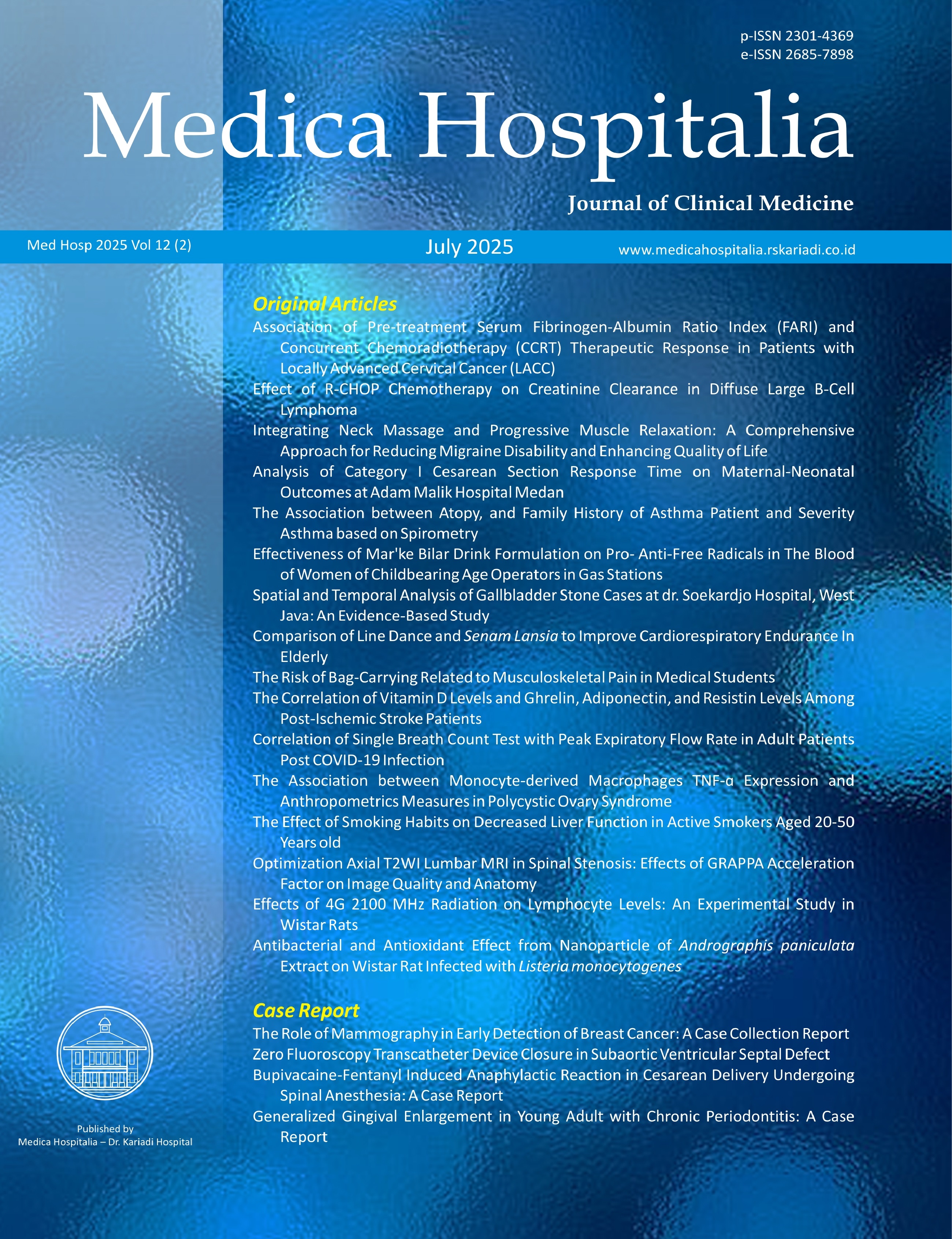Effect of R-CHOP Chemotherapy on Creatinine Clearance in Diffuse Large B-Cell Lymphoma
DOI:
https://doi.org/10.36408/mhjcm.v12i2.1153Keywords:
Creatinine clearance, Diffuse large B-cell lymphoma, R-CHOPAbstract
BACKGROUND: Diffuse large B-cell lymphoma (DLBCL) is the most common type of non-Hodgkin's lymphoma (LNH). First-line therapy for DLBCL is a combination regimen of Rituximab, Cyclophosphamide, Hydroxydoxorubicin, Vincristine (Oncovin), and Prednisone (R-CHOP). The CHOP regimen causes acute kidney injury (AKI) directly or mediated by reactive oxygen species (ROS). AKI is associated with significant morbidity and mortality in cancer patients, including high mortality, increased hospitalization, and a lower cancer remission.
AIM: Analyzing the effect of R-CHOP chemotherapy on creatinine clearance values in DLBCL lymphoma patients
METHOD: Analytical observational study with a retrospective design involved 38 patients diagnosed with DLBCL who underwent R-CHOP chemotherapy at RSUP dr. Kariadi Semarang. The independent variable of the study was the frequency of chemotherapy. The dependent variables of the study were serum creatinine levels and creatinine clearance which were measured in 4 phases, namely before, post 3x-, post 4x- and post 5x- R-CHOP chemotherapy. Analysis used the Friedman, T-dependent, and Wilcoxon tests.
RESULT: The creatinine clearance value of DLBCL lymphoma patients before administering R-CHOP had a normal value with an average of 68.98 mL/min. The creatinine clearance value of DLBCL lymphoma patients after administering R-CHOP after 3x chemotherapy was found to be an average of 78.26 mL/min, after 4x chemotherapy the average was 75.50 mL/min and after 5x chemotherapy the average was 73.24 mL/min. There was a significant difference in creatinine clearance values for DLBCL lymphoma patients before and after administration of R-CHOP (p=0.018).
CONCLUSION: Administration of R-CHOP chemotherapy has a significant effect on the creatinine clearance value of DLBCL lymphoma patients.
Downloads
References
1. Hounsome L, Eyre TA, Ireland R, Hodson A, Walewska R, Ardeshna K, et al. Diffuse large B cell lymphoma (DLBCL) in patients older than 65 years: analysis of 3 year Real World data of practice patterns and outcomes in England. Br J Cancer. 2022 Jan 1;126(1):134–43. doi:10.1038/s41416-021-01525-4
2. Morrison VA. Frontline therapy with R-CHOP for diffuse large B-cell lymphoma: Where have we come (or not come)? A Perspective. J Geriatr Oncol. 2021 Mar;12(2):320–5. doi:10.1016/j.jgo.2020.09.015
3. Santos MLC, Brito BB de, Silva FAF da, Botelho AC dos S, Melo FF de. Nephrotoxicity in cancer treatment: An overview. World J Clin Oncol. 2020 Apr 24;11(4):190–204. doi:10.5306/wjco.v11.i4.190
4. Indriyanti N. Nephrotoxicity Risk of Cyclophosphamide in Lupus Model. Journal of Tropical Pharmacy and Chemistry. 2021 Jun 30;5(3):218–22. doi:10.25026/jtpc.v5i3.289
5. Sabapathy V, Cheru NT, Corey R, Mohammad S, Sharma R. A Novel Hybrid Cytokine IL233 Mediates regeneration following Doxorubicin-Induced Nephrotoxic Injury. Sci Rep. 2019 Dec 1;9(1):3215. doi:10.1038/s41598-019-39886-9
6. Małyszko J, Kozłowska K, Kozłowski L, Małyszko J. Nephrotoxicity of anticancer treatment. Nephrology Dialysis Transplantation. 2016 Oct 5;gfw338. doi:10.1093/ndt/gfw338
7. Meng XM, Nikolic-Paterson DJ, Lan HY. Inflammatory processes in renal fibrosis. Nat Rev Nephrol. 2014 Sep 1;10(9):493–503. doi:10.1038/nrneph.2014.114
8. Kang E, Park M, Park PG, Park N, Jung Y, Kang U, et al. Acute kidney injury predicts all‐cause mortality in patients with cancer. Cancer Med. 2019 Jun 9;8(6):2740–50. doi:10.1002/cam4.2140
9. Rosner MH, Perazella MA. Acute kidney injury in the patient with cancer. Kidney Res Clin Pract. 2019 Sep 30;38(3):295–308. doi:10.23876/j.krcp.19.042
10. Hedström G, Hagberg O, Jerkeman M, Enblad G. The impact of age on survival of diffuse large B-cell lymphoma – a population-based study. Acta Oncol (Madr). 2015 Jul 3;54(6):916–23. doi:10.3109/0284186X.2014.978367
11. Abu Sabaa A, Mörth C, Hasselblom S, Hedström G, Flogegård M, Stern M, et al. Age is the most important predictor of survival in diffuse large B‐cell lymphoma patients achieving event‐free survival at 24 months: a Swedish population‐based study. Br J Haematol. 2021 Jun 5;193(5):906–14. doi:10.1111/bjh.17206
12. Istiadi H, Sadhana U, Puspasari D, Miranti IP, Karlowee V, Listiana DE, et al. Prognostic significance of double expressor lymphoma subtype in patient with diffuse large B-cell lymphoma. Bali Medical Journal. 2021 Apr 30;10(1):366–72. doi:10.15562/bmj.v10i1.2188
13. Flowers CR, Sinha R, Vose JM. Improving Outcomes for Patients With Diffuse Large B-Cell Lymphoma. CA Cancer J Clin. 2010 Oct 28; doi:10.3322/caac.20087
14. Hounsome L, Eyre TA, Ireland R, Hodson A, Walewska R, Ardeshna K, et al. Diffuse large B cell lymphoma (DLBCL) in patients older than 65 years: analysis of 3 year Real World data of practice patterns and outcomes in England. Br J Cancer. 2022 Jan 1;126(1):134–43. doi:10.1038/s41416-021-01525-4
15. Do TN, Ucisik-Akkaya E, Davis CF, Morrison BA, Dorak MT. An intronic polymorphism of IRF4 gene influences gene transcription in vitro and shows a risk association with childhood acute lymphoblastic leukemia in males. Biochimica et Biophysica Acta (BBA) - Molecular Basis of Disease. 2010 Feb;1802(2):292–300. doi:10.1016/j.bbadis.2009.10.015
16. Kim HI, Lim H, Moon A. Sex Differences in Cancer: Epidemiology, Genetics and Therapy. Biomol Ther (Seoul). 2018 Jul 1;26(4):335–42. doi:10.4062/biomolther.2018.103
17. Lisenko K, McClanahan F, Schöning T, Schwarzbich MA, Cremer M, Dittrich T, et al. Minimal renal toxicity after Rituximab DHAP with a modified cisplatin application scheme in patients with relapsed or refractory diffuse large B-cell lymphoma. BMC Cancer. 2016 Dec 11;16(1):267. doi:10.1186/s12885-016-2289-y
18. Chapman R, Shah S, D’Angelo A. Acute kidney injury following induction of chemotherapy: Diagnosis and management in critical care. J Intensive Care Soc. 2023 Feb 30;24(1):112–6. doi:10.1177/17511437221106441
19. Nishimura N, Fukuta T, Nishihara A, Shirouchi Y, Uryu H, Inoue N, et al. Impact of Creatinine Clearance in Patients with Diffuse Large B-Cell Lymphoma Treated with R-CHOP : A Real-World Long-Term Observation Analysis at a Single Institute. Blood. 2018 Nov 29;132(Supplement 1):5399. doi:10.1182/blood-2018-99-115897
20. De La Garza Gamez M, Rizo-Topete LM, Cobos-Aguilar H. Chronic Kidney Disease Secondary to Different Chemotherapy Regimens in Patients with Non-Hodgkin’s Lymphoma. Kidney Int Rep. 2023 Mar;8(3):S118–9. doi:10.1016/j.ekir.2023.02.265
21. Yasuda H, Yasuda M, Komatsu N. Chemotherapy for non‐Hodgkin lymphoma in the hemodialysis patient: A comprehensive review. Cancer Sci. 2021 Jul 11;112(7):2607–24. doi:10.1111/cas.14933
Additional Files
Published
How to Cite
Issue
Section
Citation Check
License
Copyright (c) 2025 Handhika Mustika, Willy Yusmawan, Rery Budiarti (Author)

This work is licensed under a Creative Commons Attribution-ShareAlike 4.0 International License.
Copyrights Notice
Copyrights:
Researchers publishing manuscrips at Medica Hospitalis: Journal of Clinical Medicine agree with regulations as follow:
Copyrights of each article belong to researchers, and it is likewise the patent rights
Researchers admit that Medica Hospitalia: Journal of Clinical Medicine has the right of first publication
Researchers may submit manuscripts separately, manage non exclusive distribution of published manuscripts into other versions (such as: being sent to researchers’ institutional repository, publication in the books, etc), admitting that manuscripts have been firstly published at Medica Hospitalia: Journal of Clinical Medicine
License:
Medica Hospitalia: Journal of Clinical Medicine is disseminated based on provisions of Creative Common Attribution-Share Alike 4.0 Internasional It allows individuals to duplicate and disseminate manuscripts in any formats, to alter, compose and make derivatives of manuscripts for any purpose. You are not allowed to use manuscripts for commercial purposes. You should properly acknowledge, reference links, and state that alterations have been made. You can do so in proper ways, but it does not hint that the licensors support you or your usage.
























